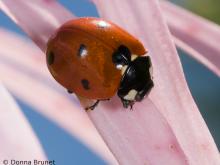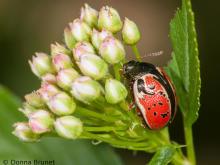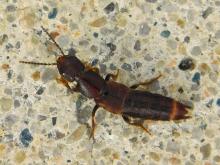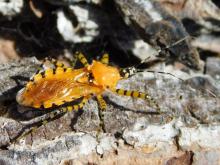Land Invertebrates
Media

Species Types
Scientific Name
Brachiacantha quadripunctata
Description
Not all Missouri lady beetles are red with black spots. The four-spotted lady beetle reverses the pattern.
Media

Species Types
Scientific Name
Coccinella septempunctata
Description
The seven-spotted lady beetle is native to Eurasia and was introduced to our continent to combat aphid pests. It is now well established in North America.
Media

Species Types
Scientific Name
Calligrapha spiraea
Description
The ninebark calligraphy beetle is one of nearly 40 North American calligraphy beetles, named for the scrawly markings on their backs. Most calligraphy beetles require particular host plants.
Media

Species Types
Scientific Name
Saperda tridentata
Description
The elm borer is a longhorned beetle whose larvae bore galleries under the bark of elm trees. The orangish markings on the adults are distinctive.
Media

Species Types
Scientific Name
About 2,000 species in North America north of Mexico
Description
Plant bugs, or mirids, are a huge family of true bugs. They are often overlooked — except by gardeners and farmers. Most mirids eat plants, and some are agricultural pests. As a group, they’re an important food source for birds and other insectivores.
Media

Species Types
Scientific Name
More than 4,400 species in North America north of Mexico
Description
Rove beetles usually have very short wing covers, so several of their hind abdominal segments are exposed. Typically fast movers, they often flip up their abdomen tips when frightened. This is a huge family of beetles.
Media

Species Types
Scientific Name
About 300 species globally
Description
True velvet mites: You’ve probably seen these small, velvety, bright red mites creeping around on rocks, plant containers, tree trunks, or on the ground, especially after a rain. Be not afraid! They are harmless — to people.
Media
Species Types
Scientific Name
About 11 species in North America north of Mexico
Description
Mantidflies look like a cross between a lacewing insect and a praying mantis. They are small, delicate creatures with intricately veined wings, but the front half looks like a mantid, complete with raptorial forelegs.
Media

Species Types
Scientific Name
About 175 species in North America
Description
Earthworms are familiar to just about everyone who digs in the soil. They play a major role in the nutrient cycling and structure of soils. There are many species. The most familiar ones in Missouri are nonnative.
Media

Species Types
Scientific Name
Pselliopus barberi
Description
The orange assassin bug, Pselliopus barberi, is about ½ inch long and is one of our most attractive non-butterfly insects. They overwinter in groups as adults under loose bark.
See Also



Media

Species Types
Scientific Name
Cisseps fulvicollis
Description
The yellow-collared scape moth is more often “orange-collared.” And whether you think it looks more like a firefly or a wasp, it’s still a moth!
Media

Species Types
Scientific Name
Nearly 150 species in North America north of Mexico
Description
Slim, delicate plume moths are instantly recognizable by their T-shaped silhouette, long legs, and muted shades of tan and brown. It can be hard to separate the various species.
Media

Species Types
Scientific Name
Pyrrharctia isabella
Description
Not many people know the adult Isabella tiger moth when they see one, but we’re all acquainted with its caterpillar, the woolly worm, or woolly bear.
About Land Invertebrates in Missouri
Invertebrates are animals without backbones, including earthworms, slugs, snails, and arthropods. Arthropods—invertebrates with “jointed legs” — are a group of invertebrates that includes crayfish, shrimp, millipedes, centipedes, mites, spiders, and insects. There may be as many as 10 million species of insects alive on earth today, and they probably constitute more than 90 percent all animal species.





















